H.T.M.S. Under Water Learning Site Project

Back in 2010, the seawater temperature stayed over 30.5 degrees Celsius for a long period of time resulted in widespread coral bleaching under the Thai seas.
The warmer seawater and dead corals had a chain effect on other marine lives. Coral reefs serve as nursery and sanctuary for young sea animals from predators for grown ones. Their health is inherently tied to that of the marine ecosystem and the livelihood of the local communities depending on the sea to provide them with food and income from fishery and tourism.
At marine scientists' meeting organized by the Department of Marine and Coastal Resources to deliberate on how to tackle the situation, one recommendation was to build "Man-made dive sites". Because studies had found that when a natural coral reef becomes popular among divers, it tends to heavily be affected. However, closing a natural dive site or forbidding people from visiting the coral reefs would affect the local people's income in the tourism industry. In this situation, creating alternative dive sites would reduce the negative impact on natural coral reefs and allow them time to recover from bleaching.
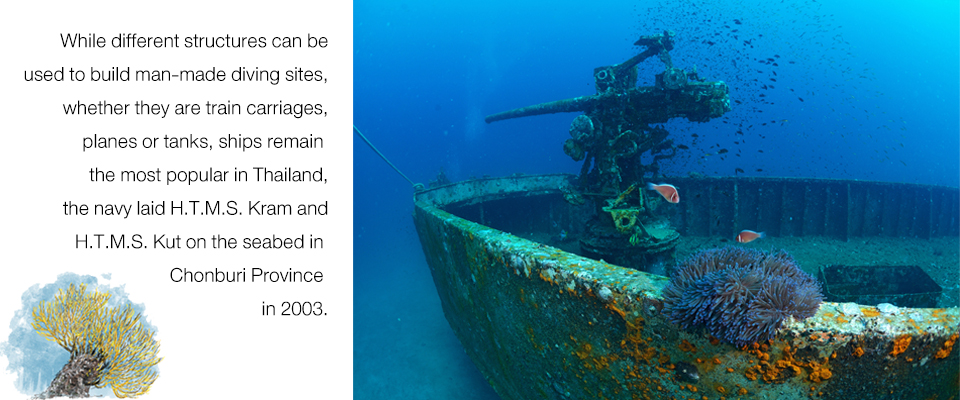

As an operator of petroleum E&P projects in Thailand, PTTEP threw its support behind "the H.T.M.S. Underwater Learning Site Project" by studying and developing methods to transform former battleships to be underwater tourist attractions in Chumphon and Surat Thani Provinces. The project is a collaborative effort with various agencies including the Department of National Parks, Wildlife and Plant Conservation, the Department of Marine and Coastal Resources, Chumphon and Surat Thani administrations, local business operators and communities as well as the Royal Thai Navy and Kasetsart University's Department of Fishery served as the project's major driving force.
For this project, the Navy offered two suitably sized decommissioned ships for the project, namely H.T.M.S. Prab and H.T.M.S. Sattakut. Their histories themselves are impressive destinations for divers as wreck dive sites.
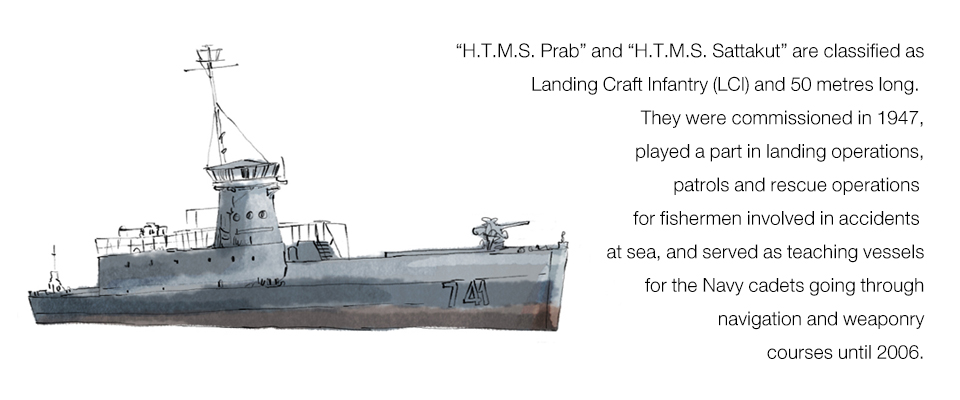

The important criterion for the man-made dive site is the location: it must reduce impacts on the coral reef. That means the chosen location must be conveniently accessible to divers, and not too far from natural coral reefs which are known tourist attractions either.
Hence, before two former battleships were scuttled on the seabed, discussion was held with various agencies and stakeholders. To find out the most suitable place to rest the ships, the studies on the underwater ecology and marine life diversity were conducted before and after sinking and studied the sea currents, visibility, topography and the number of marine animals. Koh Tao, Surat Thani Province and Koh Ngam Noi, Chumporn Province fit all the criteria.
At Koh Tao, the team chose a location close to Hin Khao (White Rock) formation, which is a major diving spot in the west of the island, an important habitat of sessile organisms such as corals, mushroom anemones, sea anemones, coralline algae, black coral and sea sponges. Meanwhile, this is a swallow's nests concession island, Koh Ngam Noi – is also a popular diving site, which is characterized by a steep limestone cliff.
Another major aspect of the operation is preparing the battleships for their last mission to ensure that the ships would have a minimal impact on the marine ecology, which included cleaning and re-painting the hulls with lead-free paint, removing materials that may harm marine animals such as fiber, etc. Removing the structures and elements that might cause harm and hook the divers and installing signs to inform site-specific area for wreck diver.
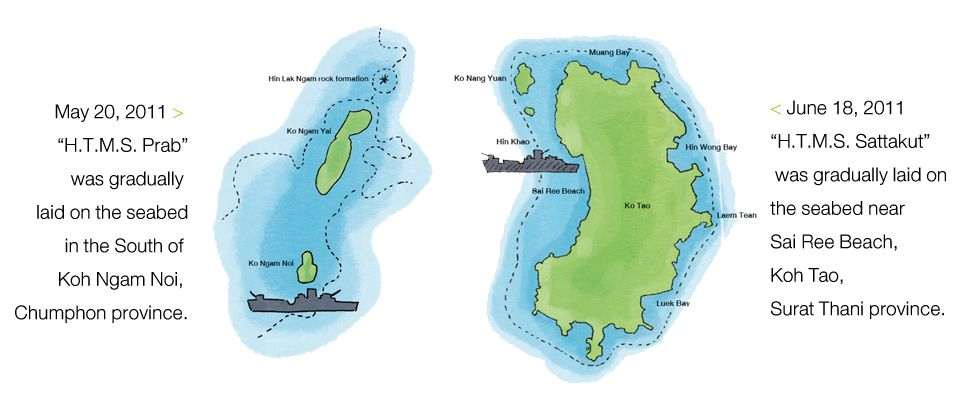

Ceremonies to lay the former battleships down into the sea were over, but the ships mission will never end. Another important aspect of the project is measurement of marine ecological impacts. The study is set up and divided into three areas: the study of environmental impact began as soon as the ships were lowered to the seabed. The study included monitoring the amount of stirred-up sediments, garbage or any substance, conditions of the seabed and currents. The results show that there was no significant impact in every area study and the sessile organisms and fish remained in the same conditions; the study of living organisms, a group of trevallies circled around the wrecks was found on the first day. A year later, more than 40 new species were found in the area and the number of newly-found fish rise by approximately 60-70 afterwards. Around H.T.M.S. Prab, whale sharks were spotted regularly. At the depth of 18 meters, certain species of sponges were found and distinguished as prominent. Further down at the depth of 25 meters, the dominant species such as black corals were found; the study of using the shipwrecks as alternative diving sites to draw tourists away from decaying natural coral reefs was met with great success. These days, boats take turns coming in and out of the wreck sites to take tourists to explore the underwater abundance.
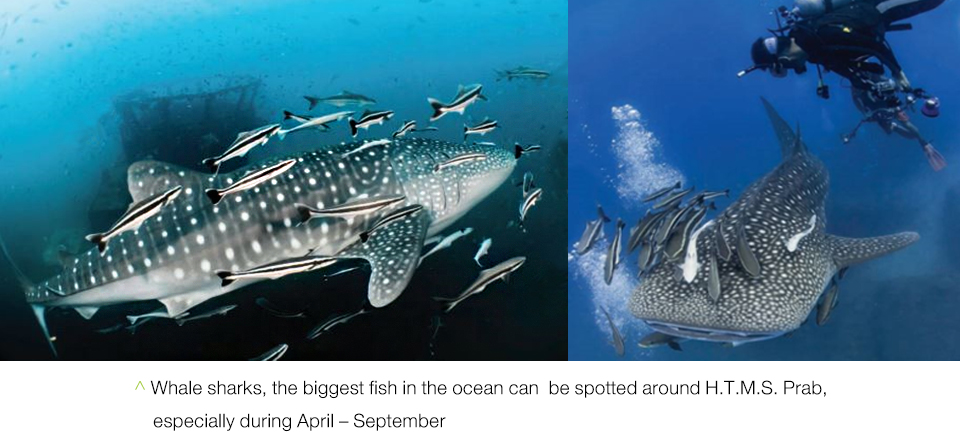
The two ''training battleships" from the Thai Navy have helped protect the integrity of the Thai seas beyond all expectations.

Although the creation of man-made dive sites represents a remarkable attempt to protect coral reefs, their long-term conservation demands more work. As the higher numbers of boats upon an increasing of tourists travel into this area to explore marine lives and nature, the mere act of their anchoring could cause a lot of damage to the marine resources. Koh Tao is one of the most visited diving sites in the world. Its coral reefs area mostly full of visitors both Thai and foreigner that come to enjoy the exquisite coral reefs every day. A major concern was boat anchoring that's risky to hit the coral reefs. Whereas PTTEP joined to continuously support the construction of a concrete base, a mooring buoy and their maintenance to encourage tourist boat driver to anchor far from natural coral reefs area.
Today, H.T.M.S. Prab and H.T.M.S. Sattakut have been turned into popular dive sites.
For ten years, these two battleships have been recognized to serve as artificial coral reefs. A wealth of marine biodiversity at the sites has eventually attracted divers and tourists to learn more about the history of Thai battleships. This has generated jobs and income for local communities and businesses approximately Baht 59 million per year from more than 28,000 visitors per year. PTTEP has carried out analysis on Social Return on Investment (SROI) of this project by translating social and environmental outcomes, compares to the value from project investment of time, money and other resources. It appears that the value of the SROI ratio is 5.34: 1.
H.T.M.S. Underwater Learning Site Project received many international awards including Gulf Sustainability Awards 2021 (Silver) Best Community Development (The United Arab Emirates), Global CSR award 2020 - Platinum Winner (India), Stevie Award (Silver) Innovation in Community Relations (Singapore), Best CSR Campaign (Indonesia), Best Environmental Excellence Award – Gold (Indonesia) and Green Leadership (Philippines).
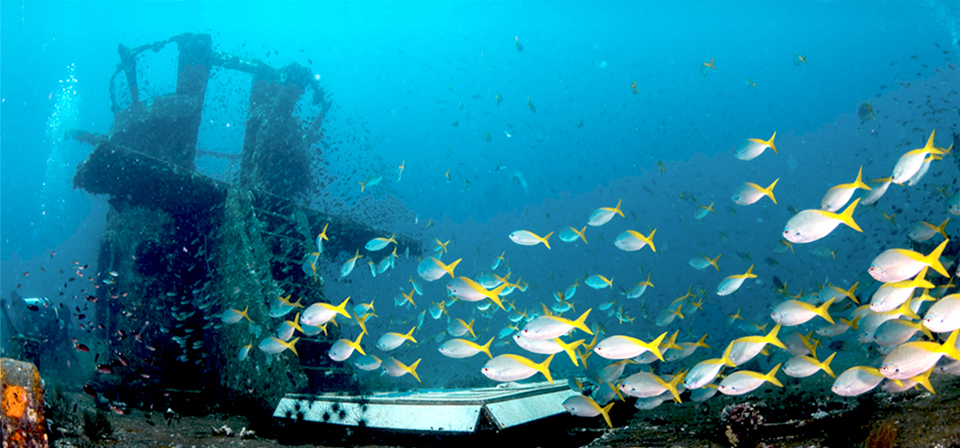



 ...the sea has become our home and so we are conscious of our responsibilities...
...the sea has become our home and so we are conscious of our responsibilities...




 PTTEP is E&P company in Thailand, exploring for sustainable sources of petroleum for the countries we operate
PTTEP is E&P company in Thailand, exploring for sustainable sources of petroleum for the countries we operate
 SIGN IN
SIGN IN SEARCH
SEARCH







